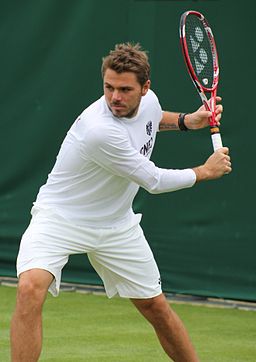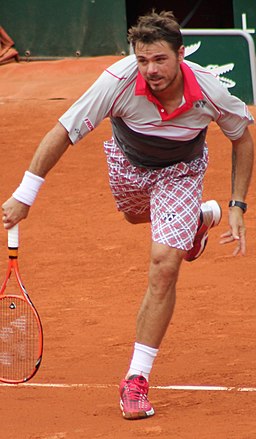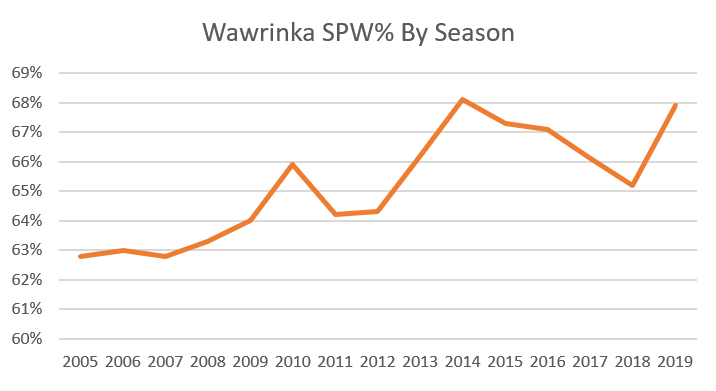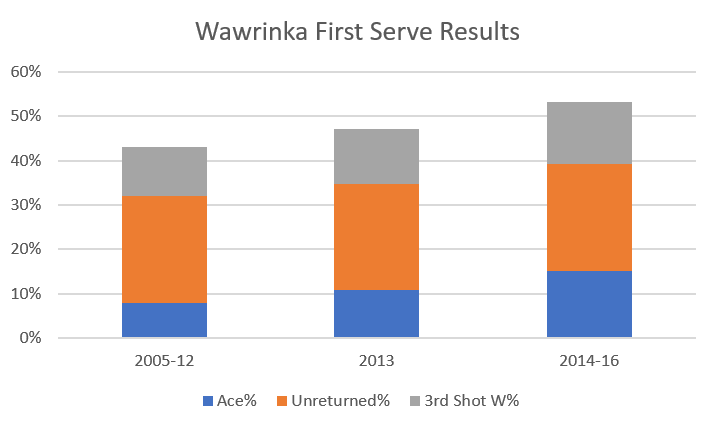
Credit: si.robi
In 2022, I’m counting down the 128 best players of the last century. With luck, we’ll get to #1 in December. Enjoy!
* * *
Stan Wawrinka [SUI]Born: 28 March 1985
Career: 2005-present (17+ seasons)
Plays: Right-handed (one-handed backhand)
Peak ATP rank: 3 (27 January 2014)
Peak Elo rating: 2,146
Major singles titles: 3
Total ATP singles titles: 16
* * *
Stan Wawrinka has played 842 tour-level matches in his career. More than one in ten have come against Novak Djokovic, Roger Federer, Andy Murray, or Rafael Nadal. He’s run into the Big Four in 13 of his 30 ATP finals–including, of course, all four of his grand slam championship matches.
No one outside of the quartet themselves has played the Big Four more often at majors than Wawrinka has. No other man has faced all four at least 20 times. Tomas Berdych tops the list of most total matches against the famous foursome–with Wawrinka a single match behind him.
The most important number for the perennial Swiss #2 reflects what actually happened in those meetings. He beat members of the Big Four 21 times, more than any other outsider. Richard Gasquet, Tommy Haas, and Gilles Simon combined for the same number of victories–and they collectively needed 53 more chances to do so.
* * *
Wawrinka was 27 years old at the close of the 2012 season. The ATP computer ranked him 17th, behind fellow 27-year-olds Berdych, Gasquet, Jo-Wilfried Tsonga, Nicolas Almagro, and John Isner. In eight years on tour, he had won three titles, all 250s, one of them a victory by retirement in the final against Djokovic. He had reached only two grand slam quarter-finals in 31 tries.
By that time, most of us had given up hope that Berdych, Tsonga, or Gasquet–or anyone else–would finally break the Big Four stranglehold and start winning majors. Even among that group, Wawrinka was an afterthought. He had lost 36 of his last 39 meetings with the Big Four, a run dating back to 2007.
Whatever he did to prepare for the 2013 season, it worked. He kicked off the campaign with a five-hour battle in the Australian Open fourth round, where he fought Djokovic all the way to 10-10 in the fifth set. He wouldn’t finally beat the Serbian until the following year in Melbourne, and he would endure another eight losses in ten meetings with the Big Four before the end of 2013. But he won 70% of matches that season for the first time in his career, battled Djokovic to another fifth set in New York, reached his first Masters final, and ascended to a new career-best ranking of #8, leapfrogging Tsonga and Gasquet and nearly closing the gap with Berdych.
Some of the credit belongs to his partnership with coach Magnus Norman, a former major finalist who joined his team in April of that year. Norman came on board after the breakthrough in Melbourne that year, but the uptick in Wawrinka’s fortunes coincides closely with the Swede’s arrival by Stan’s side. As early as November of that year, Wawrinka credited his new coach with both tactical assistance and–just as important–the tools necessary to stick with those tactics in tough matches.
In January of 2014, it all came together. Wawrinka beat Djokovic and Nadal to win his first major title, at the Australian Open. He was the first man outside the Big Four to win a slam since Juan Martin del Potro in 2009, and the first in Melbourne since Marat Safin in 2005. By the end of 2016, he had increased his grand slam tally to three, equalling Murray and making him one of only 20 men in the Open Era to win so many.
What changed? How did a man ranked as the fifth-best 27-year-old at the midpoint of his career become one of the best players of the last century?
* * *
I want to say it was the backhand, the sexy, overpowering one-hander that makes Gasquet look like an elderly coach feeding balls to a beginner.
It wasn’t the backhand–at least, it wasn’t a major improvement in the backhand. Coach and commentator Patrick Mouratoglou recently called Wawrinka’s shot “the most powerful backhand on the circuit,” while pointing out that it’s been a notable weapon since Stan was a junior. The backhand has improved as he has gotten stronger, but that doesn’t explain such a meteoric–and belated–rise.
The history of tennis is riddled with underachievers who couldn’t assemble a complete game to accompany one brilliant shot. Plus, if you’re going to build your game around one otherworldly stroke, a backhand isn’t the one to pick.
Instead, Wawrinka massively improved the effectiveness of his serve. Take a look at his year-by-year percentage of serve points won (SPW):
From a mark below 65% in 2011 and 2012, Stan improved to 68% in 2014. His career average through 2012 was below 64%, and his career average since is close to 67%.
Three percentage points might not sound like much. Yet it’s an enormous difference. Every tour player of consequence sits in the range between 60% and 70%, with the occasional exception of a monster server who creeps into the low 70s. In 2021, three percentage points was the difference between the devastating serve of Daniil Medvedev and the middling one of Pablo Carreno Busta.
It’s a good thing Wawrinka developed his serve when he did, because after the 2013 season, his return game went the other way. After breaking serve between 24% and 25% of the time from 2010 to 2013, his break rate fell to 21% in 2014 and 2015. Apart from a small bounce back in 2016, it has never recovered.

Credit: si.robi
Some of the return-game downturn is a mirage. Thanks to his improved results, he faced a tougher mix of opponents. Perhaps his return stayed roughly the same, while his results reflected the more challenging competition. If so, his leap in service effectiveness, against that same set of elite opponents, is all the more impressive.
It’s clear what improved as Wawrinka went from an outsider to the man who forced people to say “Big Five.” But why?
* * *
In 2014, Wawrinka hit aces like he never had before. He tallied free points at a rate around 8% until 2013, so his 2014 mark of 10.7% represented a huge step forward. He aced Djokovic 10% of the time at the 2014 Australian Open, compared to 7.5% at the same tournament the year before. And his first serve played a key role in his first major championship match, when Nadal failed to get a racket on nearly one in five of his offerings.
Yet the serve itself doesn’t tell the whole story. Since 2014, his ace rate has settled in around 9%, only a modest improvement on what came before.
Using data from the Match Charting Project, let’s see how Wawrinka won first serve points before 2013, in 2013, and in his three peak seasons from 2014-16:
Charted matches aren’t the complete record, nor are they a purely random sample, so the ace rates don’t match the overall numbers I mentioned above. For some reason, we chose to chart a lot of Wawrinka’s best ace days in his peak years, so the blue part of each bar shows a significant improvement in ace rate.
The orange portions reflect non-aces that still weren’t returned. That percentage stayed almost the same in each phase.
The gray segments at the top of each bar show points that Stan won with the third shot of the rally–his second swing–either by hitting a winner or inducing a forced error from his opponent. That number steadily increases, from 11% up to 2012, to 12.5% in 2013, to 14% in 2014-16.
The improvement in his second shots is even more noticeable when you consider that fewer balls came back in his peak years. You can’t hit a serve-plus-one winner if the serve doesn’t come back! If we consider how often he ended the point with his second swing as a percentage of opportunities, it’s 16% from 2005-12, 19% in 2013, and 23% during his three-year peak.
Wawrinka explained his change in tactics at the end of 2013: “I don’t wait for the other player to miss.” Against the defensive capabilities of Djokovic, Murray, and Nadal, all of whom had an annoying tendency not to miss, it was really his only option.
And it was more than just a tactical shift. A year after joining Team Wawrinka, Magnus Norman weighed in: “Technically, it’s his forehand that progress is the most significant. His margin over the net is now larger, and he now has more confidence in [it]. … Stan has always had an incredible ball hit.”
The forehand is a crucial part of the serve-plus-one game. For a player already armed with an elite backhand, it was the remaining weapon with the most potential.
* * *
Once again, these percentage-point increases–16% to 19%, 19% to 23%–may seem insignificantly small. But we have to remember that the difference between a top-20 player and a top-five slam contender is itself tiny.
The evidence here suggests that Wawrinka steadily became more aggressive on the first two shots of his first serve points in the exact time frame when his results went from good to great. It worked, and he’s never gone back.
Best of all, it works against everybody. Unlike Berdych or David Ferrer, Wawrinka never thrived in the year-long grind of second-tier events, so his ranking required that he show up against the biggest guns. Even before his breakthrough, Stan wasn’t overawed by his supposed betters. He pushed Murray to five sets at Wimbledon in 2009, then beat him at the US Open in 2010. He took at least a set from Djokovic on five different occasions before 2012, and won more than half the points they played in a two-tiebreak match in 2009.
By 2013, it was obvious that no one could beat Djokovic or Murray at their own game. Unable to out-grind the grinders, Wawrinka went hard in the other direction. From 2007 until April of 2013, he lost 38 of 41 matches against the Big Four. Since clobbering Murray at Monte Carlo in 2013, he’s beaten the quartet 14 times in 46 tries, and split 18 meetings at majors.
It’s rarely so impressive to emerge from the pack just to become the fourth or fifth best player in the game. Yet to accomplish what Wawrinka did in the mid-2010s, scoring his biggest victories over one all-time great after another, sets him apart from the fifth-bests that came before him. The sexy backhand is just icing on the cake.

